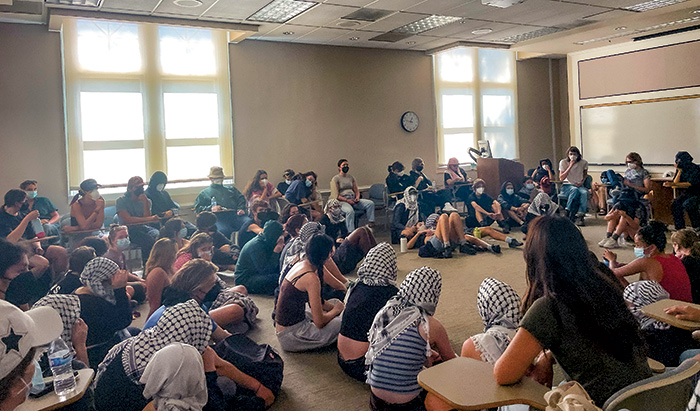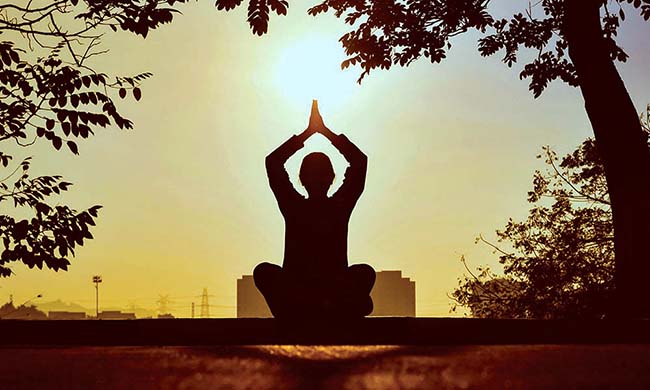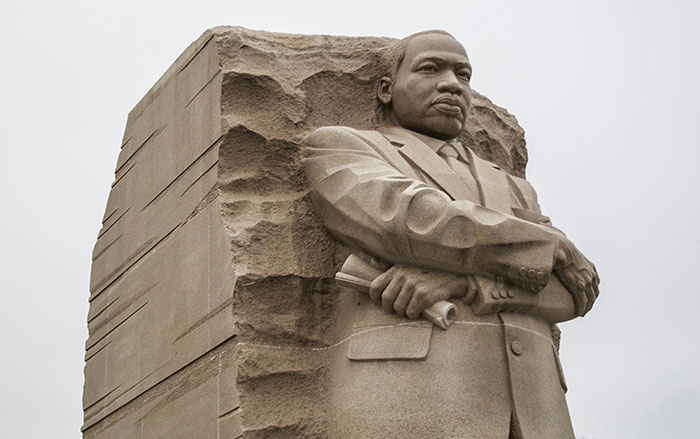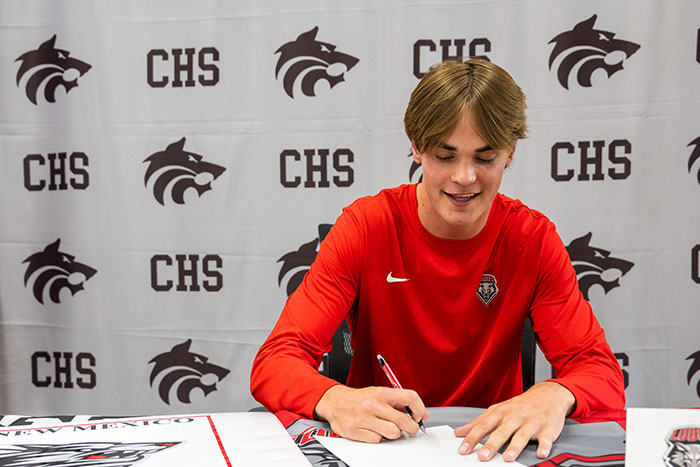Students respond to Pomona College suspensions

Demonstrators take over a classroom on the first floor of Pomona College‘s Carnegie Hall on October 7. Photo/courtesy of Julia Eason, Claremont McKenna College
by Madeleine Farr
Pomona College President G. Gabrielle Starr’s decision to suspend 10 Pomona students for the 2024-2025 academic year and ban dozens more non-Pomona students from the college’s campus has sparked outcry, namely over a lack of traditional judicial processes.
Starr distributed the punishments in response to an October 7 demonstration, where more than 100 students took over Pomona’s Carnegie Hall to mark one year protesting the Israeli government and Pomona’s investment in weapons manufacturers.
The protest began at approximately 10 a.m., with more than 400 students rallying outside Carnegie; the controversy surrounds action taken by protesters who entered the building around 11 a.m.
Starr said property destruction and harm to community members and Pomona’s academic mission were among primary transgressions against the school.
Invoking her “extraordinary authority of the president,” endowed by the college’s board of trustees, Starr suspended students without input from Pomona’s Judicial Council, a student-run group that traditionally oversees such cases.
While student reactions to the October 7 demonstration were mixed, there was a greater consensus among community members that Pomona’s reaction to the demonstration was inappropriate.
“I was hearing a lot of student opinions, not directly but from friends, that their friends thought it was super unnecessary how their protest evolved,” said Pomona sophomore Celeste Garton. However, Garton said she thought Pomona’s response was inappropriate, and that she received emails from student groups such as the Associated Students of Pomona College condemning Starr’s actions.
Pomona senior and ASPC President Devlin Orlin wrote to the college community on October 23 that he was “deeply disturbed” by Starr’s use of extraordinary authority as both student body president and a four-year Pomona College Judicial Council panelist.
“The Judicial Council was founded in the wake of brutal administrative responses to Vietnam War protests, and while it is far from perfect, it serves as an avenue in which student peers assess and repair community harm,” Orlin wrote.
A separate October 25 email from ASPC senators stated that while they believed sanctions should be applied to those who vandalized Carnegie, they also condemned Starr’s actions: “The way punishments are being doled out is punitive, excessive, and dangerous for the future of free expression at Pomona,” read the email.
The email highlighted shared concerns among the student body, including how students are being punished without evidence that they vandalized Carnegie or that they were even physically present at the protest, as well as how little input accompanied Starr’s decision.
“It should probably have gone through more of the student body, because I think the Claremont Colleges pride themselves on having a lot of student say in these matters,” said Harvey Mudd College senior Avani Narasimha.
Garton added that more faculty seem to be siding with the protesters than has been the case in the past, which indicated to her that Starr’s reaction was too intense.
“Today in class, one of my professors was participating in the blackout, which was really cool, and he just opened the class by asking us our opinions on what has happened, just created a space to talk about it,” Garton said. “I think he was meeting with student organizers after class to figure out what he could do to help.”
In the same October 25 email, ASPC senators called for a blackout demonstration, which community members could participate in by wearing black clothing on October 28. “This will serve as a safe and silent protest while ASPC works on further actions,” they wrote.
Willa Umansky, a sophomore at Pitzer College, said that there was “no balance of power in the evidence verification process. It’s the same three deans finding the evidence and confirming it.” Umansky serves as co-editor-in-chief of Pitzer publication The Outback Magazine, alongside Pitzer senior Ben Lauren, who was initially banned from Pomona due to his presence in Carnegie.
“This was despite him announcing himself as press to multiple Pomona deans and exiting the building before it was closed by Pomona administrators,” reads a collaborative opinion piece published last week in the Claremont Colleges’ newspaper The Student Life. “Due to his adherence to Pomona policy as well as the freedoms guaranteed under the California Education Code, Pomona had no choice but to overturn his ban.”
Umansky and Lauren of The Outback Magazine and senior editors from student publications The Scripps Voice and Claremont Undercurrents all contributed to the piece, which details “intimidation or retaliation from Pomona administrators for our reporting.”
“I view the bans very differently than I do the suspensions,” Umansky said. “Pomona’s acting within their right, within their ban policy which is in bounds of the 7C ban policy … it is allowed. They rewrote the rules this summer to make it so that it’s allowed.”
The new Pomona policy that has received most attention in recent weeks falls under the general guidelines of their demonstration policy, found in the 2024-2025 student handbook: “Any individual acting in a non-peaceful or disruptive manner, whether they are acting individually or within a group, may be charged on the basis of the individual’s or group’s behavior with a violation of this policy. Ignorance of this policy or lack of intent to violate this policy is not an acceptable justification for violating it.”
In the same October 25 email from ASPC senators, they condemned how at Pomona, “Collective action is being punished as individual responsibility.”
On October 28, Scripps Associated Students emailed the community with a statement from suspended students and action items they listed to help them get reinstated at the college. On October 29, the Pitzer Student Senate Executive Board sent out an email that expressed concern over Pomona’s “punitive response.”
Madeleine Farr is a Pitzer College sophomore studying politics and writing and rhetoric. She is chief copy editor at the Claremont Colleges student newspaper The Student Life, and hopes to pursue journalism after graduation.








0 Comments